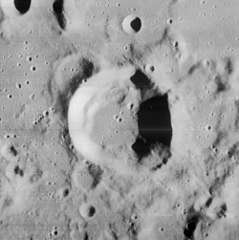Drebbel (crater)
Drebbel is a small lunar impact crater named after Cornelius Drebbel that is located to the northeast of the large walled plain Schickard, in the southwestern part of the Moon. Further to the northeast is the Lacus Excellentiae and the small crater Clausius.
 Lunar Orbiter 4 image | |
| Coordinates | 40.9°S 49.0°W |
|---|---|
| Diameter | 30 km |
| Depth | 2.5 km |
| Colongitude | 49° at sunrise |
| Eponym | Cornelius Drebbel |
The rim of this crater is roughly circular, with an outward bulge along the east and southeast side. Along this arc of the inner wall is a single terrace where the material has slumped downwards. The west and northwest sides have accumulations along the base where loose material has slumped to the floor. The remainder of the inner rim is a simple slope that runs down to the interior floor. The rim is relatively sharp-edged and not noticeably worn. There is a level interior floor that is just over half the crater diameter.
Satellite craters
By convention these features are identified on lunar maps by placing the letter on the side of the crater midpoint that is closest to Drebbel.
| Drebbel | Latitude | Longitude | Diameter |
|---|---|---|---|
| A | 38.9° S | 51.0° W | 7 km |
| B | 37.8° S | 47.3° W | 18 km |
| C | 40.4° S | 42.9° W | 30 km |
| D | 37.9° S | 49.3° W | 10 km |
| E | 38.1° S | 51.3° W | 65 km |
| F | 42.7° S | 44.6° W | 15 km |
| G | 43.9° S | 45.2° W | 17 km |
| H | 41.7° S | 45.3° W | 10 km |
| J | 40.6° S | 52.3° W | 13 km |
| K | 40.0° S | 49.5° W | 37 km |
| L | 40.3° S | 50.8° W | 9 km |
| M | 41.2° S | 41.4° W | 8 km |
| N | 41.3° S | 52.4° W | 9 km |
| P | 39.7° S | 51.8° W | 4 km |
External links
- LAC-110, lunar chart from Gazetteer of Planetary Nomenclature
References
- Andersson, L. E.; Whitaker, E. A. (1982). NASA Catalogue of Lunar Nomenclature. NASA RP-1097.CS1 maint: ref=harv (link)
- Blue, Jennifer (July 25, 2007). "Gazetteer of Planetary Nomenclature". USGS. Retrieved 2007-08-05.CS1 maint: ref=harv (link)
- Bussey, B.; Spudis, P. (2004). The Clementine Atlas of the Moon. New York: Cambridge University Press. ISBN 978-0-521-81528-4.CS1 maint: ref=harv (link)
- Cocks, Elijah E.; Cocks, Josiah C. (1995). Who's Who on the Moon: A Biographical Dictionary of Lunar Nomenclature. Tudor Publishers. ISBN 978-0-936389-27-1.CS1 maint: ref=harv (link)
- McDowell, Jonathan (July 15, 2007). "Lunar Nomenclature". Jonathan's Space Report. Retrieved 2007-10-24.CS1 maint: ref=harv (link)
- Menzel, D. H.; Minnaert, M.; Levin, B.; Dollfus, A.; Bell, B. (1971). "Report on Lunar Nomenclature by the Working Group of Commission 17 of the IAU". Space Science Reviews. 12 (2): 136–186. Bibcode:1971SSRv...12..136M. doi:10.1007/BF00171763.CS1 maint: ref=harv (link)
- Moore, Patrick (2001). On the Moon. Sterling Publishing Co. ISBN 978-0-304-35469-6.CS1 maint: ref=harv (link)
- Price, Fred W. (1988). The Moon Observer's Handbook. Cambridge University Press. ISBN 978-0-521-33500-3.CS1 maint: ref=harv (link)
- Rükl, Antonín (1990). Atlas of the Moon. Kalmbach Books. ISBN 978-0-913135-17-4.CS1 maint: ref=harv (link)
- Webb, Rev. T. W. (1962). Celestial Objects for Common Telescopes (6th revised ed.). Dover. ISBN 978-0-486-20917-3.CS1 maint: ref=harv (link)
- Whitaker, Ewen A. (1999). Mapping and Naming the Moon. Cambridge University Press. ISBN 978-0-521-62248-6.CS1 maint: ref=harv (link)
- Wlasuk, Peter T. (2000). Observing the Moon. Springer. ISBN 978-1-85233-193-1.CS1 maint: ref=harv (link)
